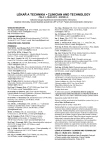Detekce pulsačních změn průměru tepen v dynamickém ultrazvukovém obraze
Authors:
Martin Sedlář; Vojtěch Mornstein
Authors‘ workplace:
Biofyzikální ústav LF MU, Brno, Česká republika
Published in:
Lékař a technika - Clinician and Technology No. 3, 2013, 43, 10-13
Category:
Original research
Overview
The pulsatile changes of diameter of blood vessels carry important information about mechanical and elastic properties of vessel wall and can be a very useful tool for measurement of functional status and diagnosis of many diseases of the vascular system.
The changes in vessel diameter we assessed in dynamic ultrasound image of femoral artery in longitudinal section. Processing and analysis was performed in Matlab®. From the input movie we created sequence of the images, that we modified by basic image preprocessing methods and methods of mathematical morphology with target to improve the results of detection, eliminate noise and disturbance structures. Time-dependent signal of artery diameter changes we obtained by evaluating brightness profiles, that were leads perpendicular to the vessel wall in all images of sequence.
Our proposed algorithm has emerged as a powerful tool for evaluating the elastic properties of arteries. The disadvantage of algorithm is its strong dependence on suitable acquisition parameters, quality and compression of the input image data.
Keywords:
ultrasound, arteries, elasticity, pulsatile changes
Sources
[1] Binder, S. Průběh pulsní vlny v závislosti na elasticitě cévního systému na arteria radialis. Olomouc: Univerzita Palackého v Olomouci, Lékařská fakulta, Ústav lékařské biofyziky, 2009.
[2] Dijk, J. M., Algra, A., Graaf, Y., Grobbee, D. E., Bots, M. L. Carotid stiffness and the risk of new vascular events in patients with manifest cardiovascular disease. The SMART study. European Heart Journal, 26 (2005): 1213–1220.
[3] Doyley, M. Model-based elastography: a survey of approaches to the inverse elasticity problem. Physics in Medicine and Biology, 57 (2012): R35–R73.
[4] Glaser, R. Biophysics. Springer, 2001. ISBN: 3540670882.
[5] Gosling, R. G., Budge, M. M. Terminology for Describing the Elastic Behavior of Arteries. Hypertension, 41 (2003): 1180-1182.
[6] Khamdaeng, T., Luo, J., Vappou, J., Terdtoon, P., Konofagou, E. E. Arterial stiffness identification of the human carotid artery using the stress–strain relationship in vivo. Ultrasonics (2011).
[7] Laurent, S., Cockcroft, J., Bortel, L., Boutouyrie, P., Giannatassio, C., Hayoz, D., Pannier, B., Vlachopoulos, Ch., Wilkinson, I., Struijker-Boudier, H. Expert consensus document on arterial stiffness: methodological issues and clinical applications. European Heart Journal, 27 (2006): 2588–2605.
[8] Mackenzie, I. S., Wilkinson, I. B., Cockcroft, J. R. Assessment of arterial stiffness in clinical practice. QJ Med, 95 (2002): 67-74.
[9] Park Dae Woo, Richards, M. S., Rubin, J. M., Hamilton J., Kruger, G. H., Weitzel, W. F. Arterial elasticity imaging: comparison of finite-element analysis models with high-resolution ultrasound speckle tracking. Cardiovascular Ultrasound, 8 (2010).
[10] Quinn, U., Tomlinson, L. A., Cockcroft, R. A. Arterial stiffness. R Soc Med Cardiovasc Dis, (2012): 1-18.
[11] Zieman, S. J., Melenovsky, V., Kass, D. A. Mechanisms, Pathophysiology, and Therapy of Arterial Stiffness. Arteriosclerosis, Thrombosis, and Vascular Biology, 25 (2005): 932-943.
Labels
BiomedicineArticle was published in
The Clinician and Technology Journal

2013 Issue 3
Most read in this issue
- Objektivní měření únavy frekvencí mrkání
- Detekce pulsačních změn průměru tepen v dynamickém ultrazvukovém obraze
- Studium mechanických vlastností s využitím mikroskopie atomárních sil
- The Influence of the Skin Fatigue, its Perspiration and the Time of Stimulation in Measurement of the Active Points on Human Skin
